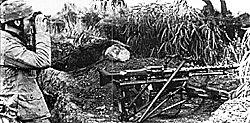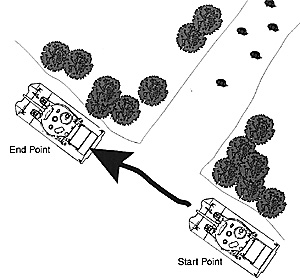 Sighting is the decisive factor in combat. The Fighter
pilot motto of "lose sight, lose the fight" applies to tbe grunt
in tbe mud as well. This sightiog update includes expanded
explanations of the sighting rules, to help gamers more easily
resolve sighting checks.
Sighting is the decisive factor in combat. The Fighter
pilot motto of "lose sight, lose the fight" applies to tbe grunt
in tbe mud as well. This sightiog update includes expanded
explanations of the sighting rules, to help gamers more easily
resolve sighting checks.
Sighting and Line of Sight are difficult concepts to quantify in game terms. In the rules we have tried to define LOS in a general way. And we have expanded on this, including rules for snow fall, forest in the winter, and darkness in our scenario packs. But because of endless variables that exist, ultimately common sense must be the arbiter. We have included some guidelines below.
Area Sighted
The rules intentionally leave vague how much area is covered by a Sighting Check. The rules refer only to "the area to be sighted" (core rules pg. 4.) The "area to be sighted', is variable depending on a number of factors. The type of target and terrain are the main factors. A open moving target will be seen much more easily than a small group of infantry crawling through a forest. This is represented on the sighting chart by a reduces chance to sight the infantry. But tbe sighting piece must also look much more closely to see the infantry than it will to see the tank. In general the larger the target, the more opeo the terrain, the larger the area will be. Since the defending player will not generally know what is being sighted for, tke GM or opposing player must use a lot of discretion.
Pick an area The sighting player should simply pick an area, such as "that woodline", "this field", or "around that building." Roll to sight as normal. Knowing what is in the araa, tbe GM or opposing player must use some judgement. For example, if the sighting player has sighted that woodline" and a tank has just moved around one side of the wood, in the open, and now in LOS of tbe sighting piece, then the tank should be included in the sighted area and revealed if the roll is sufficiently low.
A squad of infantry prone in the same spot of open ground, should not be included and not revealed. In most cases it will be clear to players and GMs what is an appropriate area to include in a sighting check.
Binoculars
Any figure who has binoculars may use them for a Sighting Check. A figure who uses binoculars may not move in an action where binoculars, other figures in the squad may move normally. A vehicle commander may also use binoculars for a Sighting Check, however, the entire vehicle may not move in an action where tbe commander has used binoculars to spot. Crew, passengers, and riders may mount or dismount as normal witbout disturbing the commander. Any enemy sighted by a figure or vehicle commander with binoculars is assumed to be sighted by the entire squad or vehicle crew. The commander of crew served weapons, such as medium machine guns or anti-tank guns, are assumed to have binoculars unless stated otherwise in the scenario.
Night Sighting
Scenarios in the Normandy Nightmare and Panthers East Scenario Packs include scenarios that occur at night. For Sighting Checks made at night, measure the range as normal and then triple it. Look up the new range of the chart, apply any modifiers, and roll to sight as normal. Any Morale Check made at night is at +2. Complete rules for night, including flares, vehicles, terrain, muzzle flashes, and noise are included in Red Devils in the Night.
Obvious Sighting
Anytime a piece takes an action that will lead to it being automatically acquired (AQ3 on the Sighting Chart) then that piece should be revealed immediately. This means, for example, that if a tank turns a corner of a road and ends up 12" away from a squad of enemy infantry marching down the same road then the tank is revealed to the infantry immediately. There is no need to wait for the squad's card to be drawn or for them to make a sighting check to see the tank. The squad will be revealed to the tank as well.
The Drive By In another example, if the same tank were to cross the road in front of the squad it would still be sighted. Even though the tank is out of LOS when the infantry rolls their Sighting Check, the tank passed right in front of them. The player controlling the infantry should be told of the tank's passing.
Drive By Example: In this example the tank begins its second action masked by the trees. For its sighting check the tank has no LOS to the German squad and cannot sight them. For its action the tank moves down the road, ending its action masked by the trees. If the tank was unbuttoned, it probably saw the squad and they should be revealed. If the tank is buttoned up it probably did not see the squad. On the squad's card the tank is out of LOS for their Sighting Check. However, because the tank obviously passed directly in front of them, the German player should be told of the tank driving past.

Back to Battle-Wire vol. 2 issue 2 Table of Contents
Back to Battle-Wire List of Issues
Back to MagWeb Master Magazine List
© Copyright 1998 by Easy Eight Enterprises, Inc.
This article appears in MagWeb (Magazine Web) on the Internet World Wide Web. Other military history articles and gaming articles are available at http://www.magweb.com